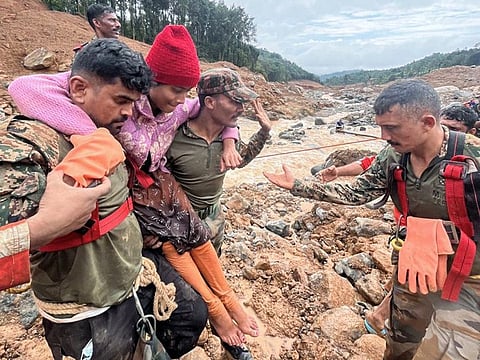Kerala landslides: Death toll crosses to 300 in Wayanad, rescue operations still underway
Around 8,000 people were taking shelter at emergency camps around the disaster site

Bengaluru: Army teams pushed deeper Friday into Indian tea plantations and villages struck by landslides that killed more than 300 people, working on the assumption that nobody was left alive to rescue.
The number of fatal floods and landslides in India has increased in recent years and experts say climate change is exacerbating the problem.
Days of torrential monsoon rains battered the southern coastal state of Kerala before twin landslides struck before dawn on Tuesday, with more than 500 soldiers among the rescue crews.
Military engineers laid a temporary bridge to speed up search efforts after earlier relying on jury-rigged ziplines to transport recovered bodies over raging waters.
"The assumption is that there is nobody left to be rescued," a statement issued late Thursday by the Kerala state government said.
Around 8,000 people were taking shelter at emergency camps around the disaster site in Wayanad district.
199 bodies recovered
State health minister Veena George said relief workers in the camps were counselling traumatised survivors and cremating dead animals in an effort to prevent disease outbreaks.
George told AFP on Friday that 199 bodies had been recovered.
But the final toll is certain to be higher, with rescuers reporting the gruesome discovery of more than 100 body parts in flood waters or buried in the muddy earth.
She further said that ICUs are kept ready in hospitals in Wayanad to provide intensive care to those rescued from the disaster areas. Hospitals including Manjeri Medical College and Kozhikode Medical College, which can reached if airlifted, are also kept on standby.
Four found alive
Meanwhile, the Indian Army during the rescue operations in Wayanad found four persons alive in the rumble including two men and two women earlier in the day.
According to the officials, the rescued individuals were stranded in the Padavetti Kunnu in Wayanad. The Army statement said that one of the rescued females was experiencing difficulties with her leg and was provided with necessary medical attention.
Earlier, the Indian Army's Engineer Task Force swiftly constructed the Bailey Bridge over the Iruvanipzha River at Chooralmala, significantly accelerating rescue operations in Wayanad.
Wayanad is famed for the tea estates that crisscross its hilly countryside and which rely on a large pool of labourers for planting and harvest.
Many of the victims were workers and their families, who lived in brick-walled row houses that were inundated by a powerful wall of brown sludge as their occupants slept.
Uprooted trees and rocks were strewn about one abandoned village in front of overturned vehicles and partially collapsed homes.
Monsoon rains across the region from June to September offer respite from the summer heat and are crucial to replenishing water supplies.
They are vital for agriculture - and therefore the livelihoods of millions of farmers and food security for South Asia's nearly two billion people.
But they also bring regular destruction in the form of flash floods and landslides.
At least 572 millimetres (22.5 inches) of rain fell in Wayanad in the two days before the landslides, according to state government figures.
Damming, deforestation and development projects in India have also exacerbated the human toll.
India's worst landslide in recent decades was in 1998, when rockfalls triggered by heavy monsoon rains killed at least 220 people and buried the tiny Himalayan village of Malpa.
Sign up for the Daily Briefing
Get the latest news and updates straight to your inbox



